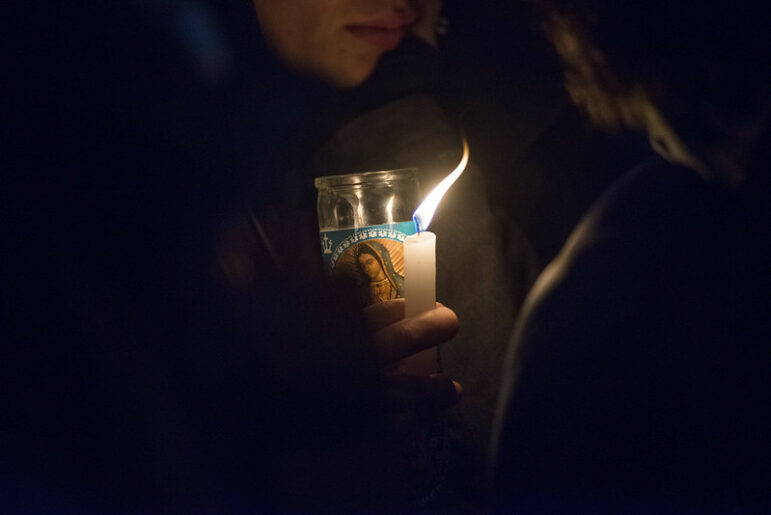“Gentrification is known to have profound effects on village life and the social fabric of cities. Ask any abuelita and she’ll tell you about new neighbors that don’t make the effort to get to know her.”

Jeff Reed/NYC Council
An attendee holds a candle at a vigil in Manhattan in 2019.Soon after, I stumbled upon a group of residents huddling in the cold and lighting up candles. It was a telltale sign of a memorial in the making. I knew then: someone had been killed in my building.
The memorial was a familiar sight; one of many I’ve encountered growing up here. In New York, particularly in communities of color, an individual’s death is frequently marked with a street memorial made of abundant candles and a poster board with farewell messages scrawled all over. These memorials function as public announcements of one’s death and serve as hubs for communal grieving; they embody village life in New York.
Village life is what makes New York so special. Here, just one block can function as a standalone village. Community ties are strong, news (and rumors) spread quickly, and eccentric characters give each block a unique flavor. I come from Washington Heights—the village of 162nd Street—where a shriek or a loud crash attracts hordes of curious onlookers and dozens of inquiring heads peering from windows well above the street. There is a sense of neighborliness and congeniality; a tacit understanding that we’re in this madness together.
Our ties become even closer when a member of the community dies. While you may not know the name of the deceased, you’ll recognize their face from your trips to the bodega, barber shop sessions, or dog walks. And if you didn’t know them, your mother probably did. A street memorial will spring up and hundreds of people will take a moment out of their journeys to acknowledge the loss of life and learn what we can of the deceased’s life from the farewell messages. Death is hard to miss in the villages of New York.
In my neighbor’s case, it appears his death was all too easy to miss. His memorial was tucked away on the side of my block-long building—well away from the front door, where they are typically placed. Unlike the memorials of my childhood, where dollar-store candles adorned with saints were allowed to burn to completion; my neighbor had his extinguished. The candles were lit on a Tuesday and by Friday the entire memorial was removed. Perhaps my corporate landlord considered it an inconvenient reminder of the grisly scene that unfolded within the building’s walls.
I live in gentrifying Bushwick in a building actively contributing to the neighborhood’s transformation. My neighbor was one of many lower-income tenants who live in the building thanks to policies like Mandatory Inclusionary Housing, which requires at least 20 percent of all new housing in rezoned areas to be developed as affordable.
While the well-meaning policy has resulted in a considerable amount of new affordable housing, it incentivizes the creation of economically stratified buildings that constrict low-income families into minorities. At a time when the average market-rate rent for a 1-bedroom apartment is $3900, we’re effectively building 80 percent of housing for the top 1 percent and just 20 percent for the rest of us.
The policy has also not changed the fact that higher-income communities have hardly built any affordable housing while low-income communities bear the brunt of this burden. And when most affordable housing is built in conjunction with luxury housing, this means that low-income communities must shoulder an influx of wealthier neighbors and their expectations. There is ever-dwindling space for working-class people and their norms and values while wealthier residents have the entire city as their playground.
Many of us have heard of codeswitching, instances when minority groups adjust their behavior to match with majorities, in academic or professional settings. Now, we’re witnessing codeswitching manifest in our homes, our places of refuge, thanks to gentrification.
Gentrification is known to have profound effects on village life and the social fabric of cities. Ask any abuelita and she’ll tell you about new neighbors that don’t make the effort to get to know her. Residents grow accustomed to bidding farewell to priced-out neighbors and businesses. Communities can expect an increase in 311 complaints from new residents seeking to police and regulate the behaviors of long-term ones. And now it appears the effects of gentrification are becoming even more insidious, altering a foundational element of human life: the way we grieve.
My neighbor’s death was erased. When his friends and family invited the community to join them in grief with a street memorial, it was promptly removed. There was no outlet for communal grieving.
Street memorials honor individuals; they declare “This person was here.” They are a physical reminder of death and the myriad of ways it strikes us. What will the future of grief look like in a world where there’s no space for street memorials or the people who build them?
Perhaps, we’ll find out via email.
Luis Perez is a lifelong New Yorker and political advocate working in public relations.









One thought on “Opinion: Is Gentrification Changing How New Yorkers Grieve?”
I’ve never had to deal with this issue. It sounds really challenging. You should ask the professionals for advice!